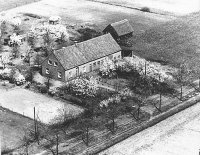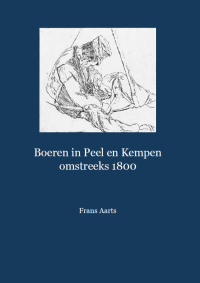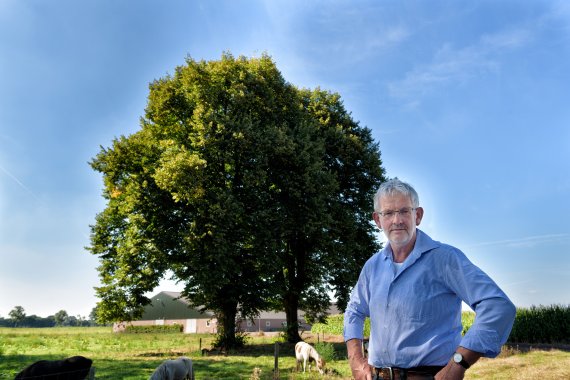The spot in Deurne where researcher Frans Aart’s parents’ farm once stood (see black & white photo). Foto: Guy Ackermans
About 30 years ago Dutch livestock farmers were throwing much too much manure onto their land, polluting the environment. Reason enough for Frans Aarts, a researcher at Plant Research International (now Wageningen Plant Research) to develop a plan for an environmentally-friendly experimental dairy farm. The farm – De Marke – opened in 1992 in Hengelo in the province of Gelderland, with Aarts as project coordinator.
Before starting up, Aarts worked out the nutrient cycle on the farm. He calculated the nutrient content of the feed, and how much of this ended up in the cow, how much nitrogen and phosphate the cow excreted in the manure, how much of this ended up on the land, and how much of this was absorbed by the grass and maize, which then served as feed. ‘We thought about how to close that cycle. Then we started taking measurements on the experimental farm, to see whether our model worked.’
De Marke became famous in the sector. ‘We produced just as much milk as an average farm, but bought less feed and hardly any artificial fertilizer, and that on the poorest soil in the Achterhoek.’ The practical knowledge gained has become compulsory fare for dairy farmers, who must use the Wageningen Annual Nutrient Cycling Assessment (ANCA) to be allowed to supply milk.

Backward
Aarts has been using all his knowledge of cycles in recent years in a historical study of farming methods in De Peel and Kempen around 1800. He wrote up his findings in a book. ‘I come from Deurne, and so did my ancestors. Life was hard there. My forefather Mathijs Aarts was born there in 1781. His wife died at the age of 37 a few months after delivering their fifth child. He remarried and three more children were born. When Mathijs died at the age of 61, seven of these eight children had died already. Only my great grandfather survived. He was ten when his father died.’
At that time Brabant was a colony of the Republic of the Seven United Netherlands, which imposed heavy taxes on the population. And an army would frequently pass by, confiscating food as it went. Aarts read a lot about this period but missed an agronomist’s perspective. ‘The historians reported that Brabant agriculture was backward, but I didn’t come across many backward farmers. A farmer has reasons for what he does; there are always underlying motives. I wanted to find them.’
Out of nothing
Aarts’s ancestors on the poor sandy soils around Deurne could not buy feed or fertilizer and yet they got surprisingly high yields, the researcher discovered while working on his book. ‘They developed farming methods using turf. Grasslands were hayed and turf was cut, and this was mixed with heather cuttings for bedding in the barn. The manure was spread on the fields, concentrating nutrients here to the detriment of the surrounding countryside.’
A livestock farmer often knows less about crops than the average allotment gardener
This was not sustainable agriculture, warns Aarts. ‘That impoverishment of the soil year after year goes wrong on the end. At some point the heath turns into a sandy desert.’ But it was smart too. ‘The Kempen farmer made something out of nothing. He kept the cows in the barn to make better use of their manure. When the feed became harder to digest, the farmer’s wife started cooking it so that the cows would eat it. The farmers turned over the soil to bring deeper-lying soil up to the surface and boost soil fertility. And they started growing corn spurrey in the autumn as an extra source of feed. They made up for the increasing exhaustion of the soils by working harder and harder.’
The French occupation in the early 19th century finally put paid to the over-exploitation. Brabant changed from a colony to a province and taxes were no longer brought to Holland, but were invested. Moreover, the farmers stopped selling rye and started feeding it to their cows, leading to an increase in cattle numbers and an adequate supply of manure. Around 1900 fertilizer was being used in De Peel and Kampen in a balanced manner.
Surplus manure
So when did it all go wrong, and did De Peel become a byword for manure surplus, acidification and stinking farms? ‘After 1950,’ says Aarts. ‘I saw it for myself: there was an exodus from farming, farmers’ sons became builders and came back to a small piece of land on their parents’ land, where they built a pig shed. Brabant was full of large families who worked hard and did everything themselves. Livestock feed was cheap, manure was no problem, so the number of pigs shot up.’
The ministry of Agriculture should have intervened immediately, says Aarts, but it didn’t. Only much later did the ministry of VROM (environment) take over the reigns, and Aarts then got the go-ahead for the experimental farm. This brings us back to 1992.
The environment has improved a lot since then, Aarts notes. ‘In the 1980s dairy farmers still applied 400 kilos of nitrogen per hectare; now they use 100 kilos, as well as less animal manure. And the yields are still good. I think it could still be 20 percent more efficient without any drop in yield. Farmers currently make silage of the grass, for instance, but perhaps you could process it differently so that more nutrients become available. In 1800 the farmers’ wives cooked the feed. Is that a good idea?’
Q fever

Boeren in Peel en Kempen omstreeks 1800, Frans Aarts, ISBN 978-94-632-3022-3. See also www.peelenkempen.nl
Something has to change in terms of environmental pollution, pathogens and landscape, says Aarts, because farmers are not going to survive without a good relationship with the rest of society. In De Peel and Kampen, as elsewhere, relations have soured, he warns. ‘I come from a farming background. That is your home so for a long time you accept the way it goes. But at some point you notice: this doesn’t feel like home anymore, this stinks. I think the Q fever outbreak was a turning point. It was already known that Q fever was dangerous, but the local people were not informed. People died and were left disabled. Then the feeling was: this isn’t my agriculture anymore.’
The agronomist sees one thing as missing from today’s agriculture: knowledge. ‘It might sound strange but the Brabant farmer around 1800 was ahead of us now. There used to be mixed farms, where the farmers could keep livestock and grow crops. Knowledge about that has declined fast in the past 40 years. The livestock farmer knows all about livestock but often knows less about crops than the average allotment gardener. He could get a lot more out of his land. We need to get the relationship back between the farmer and his soil. Only then do you get farmers with an efficient nutrient cycle.’

